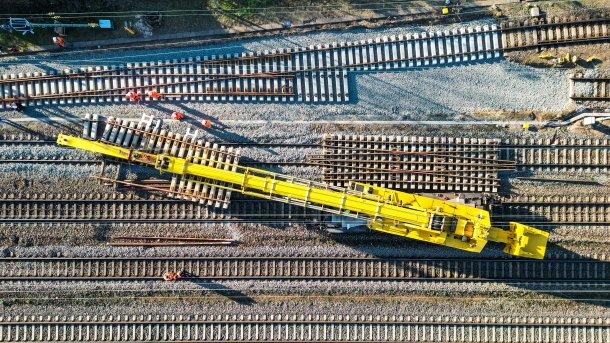Deutsche Bahn introduces construction sites with fixed intervals
In future, construction should follow the timetable and not the other way around, according to a new concept from Deutsche Bahn.

Rail-mounted slewing crane during track construction work in Mannheim
(Image: Deutsche Bahn AG / Uli Planz)
From the middle of this month, Deutsche Bahn (DB) intends to maintain and modernize the rail network on a synchronized schedule. It intends to carry out recurring maintenance work primarily during periods of low traffic. According to a DB press release, the principle of "construction at regular intervals" could mean half as many timetable changes for passenger and freight trains by 2026 as is currently the case. In the time windows for the work, several trades would be bundled together, after which there could be longer periods without work.
Passengers and freight customers should therefore be significantly less affected by construction site-related restrictions from mid-July. Construction partners, public authorities and rail transport companies could reliably prepare for the construction work. This would allow them and DB to deploy their resources more efficiently.
"Stable timetables"
Until now, DB's planners had to go through a complex process to find times for construction sites when trains could not run. This has further reduced the already tight capacities in the rail network during a constantly increasing number of construction sites. Now "construction follows the timetable - and not the other way around", explains Philipp Nagl, CEO of DB InfraGO. "We are organizing ourselves better, becoming more efficient and building more in the same amount of time in future - so that fewer customers are affected by roadworks and can rely on stable timetables."
From next week, DB first wants to change its maintenance management. Maintenance teams will then be deployed on defined sections of track to carry out the necessary inspection and repair work kilometer by kilometer. This approach should ensure fewer construction sites at short notice, reduce susceptibility to faults and stabilize the system.
"Longer time windows"
In the coming years, DB also wants to introduce the new construction site management system for construction work on larger expansion and modernization projects. There will then be longer time windows for extensive construction work. The concept envisages that construction work will not be carried out in parallel on a corridor and on important detour routes. The deployment of employees and machines could be aligned with predefined time windows. In future, construction machinery could be deployed in twice as many shifts.
This year, DB is starting a general overhaul of important rail corridors. It calls it "bundled renewal and modernization of the rail network and stations". The Mannheim - Frankfurt/Main section is due to start in mid-July. Further major projects of this kind are scheduled until 2026. At the same time, DB wants to ensure that rail traffic is more punctual with smaller and medium-sized construction projects. It presented a concept for this in April. This year, DB InfraGo plans to extend, modernize and renew 2,000 kilometers of track, 2,000 points, 150 bridges and 1,000 stations.
(anw)